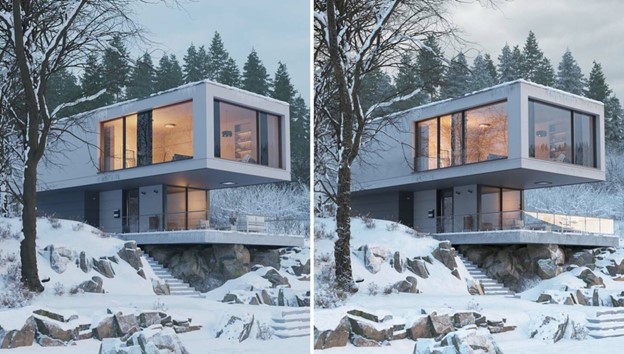Chaos has updated its Corona renderer to Version 12, and among the new features is the ability to export scenes to Chaos Vantage, enabling Corona users to tap the power of the GPU for real-time raytracing—a first with the Corona renderer—for scene exploration and rendering. With this integration, users can opt for a CPU or GPU rendering workflow based on their hardware and project needs.

(Source: Chaos)
When Chaos acquired Render Legion, with its Corona Renderer, in 2017, some in the industry questioned how long Chaos, with its own popular V-Ray, would continue development on both renderers. At the time, Chaos had said it planned to retain and continue forward with both. And it has.
Chaos has just launched Corona 12, which brings real-time ray tracing to archvis users for the first time through a connection with Chaos Vantage. As a result, architectural visualization scenes can be explored, rendered, and animated in real time, for faster workflows.
A CPU-based photorealistic render engine, Corona can perform biased and unbiased rendering. The physically-based V-Ray, on the other hand, is a hybrid offering that supports both CPU and GPU rendering.
Ray tracing is very computationally intensive; real-time ray tracing brings that to a new level. While the CPU and GPU can handle real-time rendering, the increased proficiency of recent GPUs make them better suited to handle this type of workload. And now, with Corona-to-Vantage export capability, Corona 12 users can take advantage of both speed and image quality achieved by tapping into their system’s GPU.
Corona files can be exported in .vrscene format and opened in Vantage, where they can be navigated in real time and rendered in seconds. Chaos notes this is especially useful for faster scene exploration, test renders, and final renders when photorealism is not required. When that is needed, however, users can switch back to Corona and render those scenes on the CPU by replicating the camera angles discovered when in Vantage. Corona scenes can be imported into Vantage to create animations using Vantage’s animation features, where they can be GPU-rendered quickly.
A new and improved Virtual Frame Buffer (VFB) has been introduced in Corona 12. VFB 2 enables users to drag and drop a Corona EXR file into the VFX and continue editing it, even without loading the original scene in 3ds Max or Cinema 4D. A new tool also makes it easier to compare A/B images with different resolutions and aspect ratios. And, users can have multiple LightMix elements, each with its own settings, enabling them to save different lighting setups in one image. There are also new gamma, lift, and gain parameters for tone mapping, and calculation of bloom and glare can be deferred until the end of the render.
Corona 12 also offers:
- Improved Corona Pattern improvements.
- Full creative control over the scattering process (for 3ds Max users only), enabling them to unlock new tools for refining procedural scatter results, using a brush to add or erase instances. (This feature is promised for Cinema 4D in the future.)
- Corona sky improvements that support for lower sun angles below the horizon, making day/night animations and stills more realistic, as well as the ability to adjust cloud density for more variation.
- Curved decals that are now able to bend 360 degrees around curved or round objects without any distortions.
- Availability of the full Corona Material Library in Chaos Cosmos, saving time when switching between the two asset libraries.
Chaos Corona 12 is available now for 3ds Max 2016–2025 (64 bit) on Windows and for Cinema 4D R17-2024 (64 bit) on Windows and Mac.
Chaos said it plans to build on the Corona-Vantage integration with a live link between the tools so that animations created in 3ds Max and Cinema 4D can be rendered in Vantage. This capability is expected to become available with Corona 13 before year-end.
